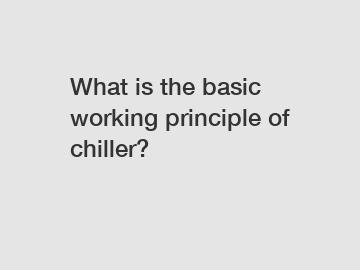What is the basic working principle of chiller?
If you are looking for more details, kindly visit Huateng.
Chillers are essential components of many HVAC systems and industrial processes. They are used to remove heat from a liquid through a vapor-compression or absorption refrigeration cycle to produce cold water or brine. But what is the basic working principle of a chiller? In this article, we will delve into the fundamental concept behind how chillers work and their key components.
### Vapor Compression Cycle.

The basic working principle of a chiller is the vapor compression cycle. This cycle consists of four main components: the evaporator, compressor, condenser, and expansion valve. The cycle begins with the evaporator, where a refrigerant (usually a compound like R134a or R410a) absorbs heat from the water or brine circulating through the system. As the refrigerant evaporates, it changes from a low-pressure liquid to a low-pressure gas.
#### Evaporator.
The evaporator is where the refrigerant absorbs heat from the chilled water or brine. As the liquid refrigerant evaporates, it absorbs heat energy, causing the temperature of the water or brine to decrease. This cold liquid is then circulated through the system to remove heat from the space or process being cooled.
#### Compressor.
The compressor is responsible for raising the pressure and temperature of the refrigerant gas. It compresses the low-pressure gas into a high-pressure gas, increasing its temperature in the process. This high-pressure, high-temperature gas is then sent to the condenser.
#### Condenser.
In the condenser, the hot, high-pressure refrigerant gas releases heat to the surrounding air or water. As the gas cools down, it condenses back into a liquid form. This liquid refrigerant is then sent to the expansion valve.
#### Expansion Valve.
The expansion valve is where the high-pressure liquid refrigerant is allowed to expand rapidly, causing it to drop in pressure and temperature. This cold, low-pressure liquid is then sent back to the evaporator to start the cycle again.
### Key Components of a Chiller.
In addition to the vapor compression cycle components, chillers also contain other key elements that help facilitate the cooling process. These include the refrigerant, control panel, and heat exchanger.
#### Refrigerant.
The choice of refrigerant used in a chiller is crucial to its efficiency and environmental impact. Modern chillers often use environmentally friendly refrigerants that have a low global warming potential (GWP) and ozone depletion potential (ODP).
#### Control Panel.
The control panel of a chiller allows operators to monitor and adjust various parameters such as temperature, pressure, and flow rate. It also helps diagnose any issues that may arise during operation and ensure the chiller is running efficiently.
#### Heat Exchanger.
The heat exchanger in a chiller is used to transfer heat between the refrigerant and the water or brine being cooled. It helps ensure efficient heat transfer and maintains the desired temperature of the chilled water or brine.
In conclusion, the basic working principle of a chiller is the vapor compression cycle, which involves the evaporator, compressor, condenser, and expansion valve. By understanding how these components work together, one can appreciate the complexity and efficiency of modern chiller systems.
If you have any questions about chillers or need assistance with your HVAC system, feel free to contact us for more information. Thank you for reading. .
**Contact us** for more details or to schedule a consultation.
For more Air Cooled Scroll Chiller Unit Petroleuminformation, please contact us. We will provide professional answers.

Comments